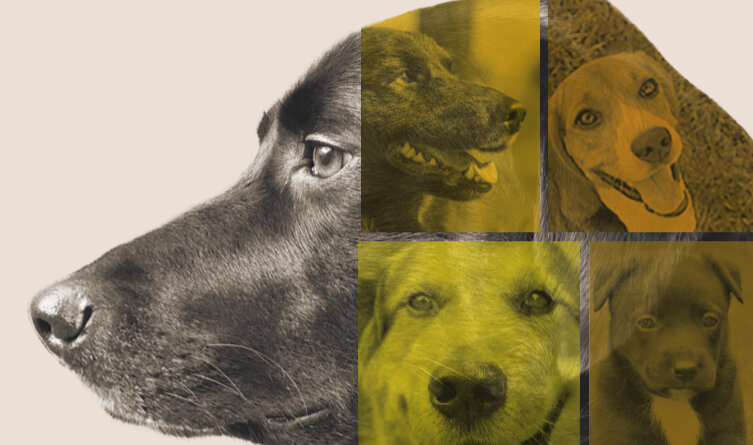Hunting For the Genes That Influence Dog Behavior
Ironically, it was Elinor Karlsson’s successful discovery of a gene responsible for compulsive behavior in dogs that made her realize she was going to have to completely redesign her research. Karlsson was on the hunt for genes affecting canine behavior, and her study of flank-sucking Doberman Pinschers had led to publication in a high-profile journal—a researcher’s bread and butter. Her discovery of a gene influential in the development of this behavioral disorder was a substantial step forward for the field of canine behavioral genetics.
But, as Karlsson likes to point out, a substantial step forward for the field didn’t translate to a finding that is useful to veterinarians, dog breeders or dog owners, because the gene she found explains only 5 to 10 percent of the risk of developing a compulsive disorder. She also found that some genetic variation important in the development of compulsive disorders didn’t show up in her Doberman-specific study; it only appeared when she started including other breeds. In other words, the gene she found doesn’t have a big enough effect on the development of a compulsive disorder to make it worth using in a genetic test, nor does it give us the full story on what is going on in the brain of a Doberman who compulsively flank sucks.
“That was when I realized we were going to need a lot more dogs,” Karlsson says.
Making the Numbers
She took a pointer from human studies of behavioral disorders. While a recent study of the genetics of canine fear and aggression sampled nearly 500 dogs, a recent successful schizophrenia study sampled more than 150,000 humans, and the numbers continue to climb. Of course, in human medicine, existing infrastructure allows many researchers to collaborate to attain these astronomical enrollment numbers. No such infrastructure exists in the veterinary world; in fact, for many behavioral problems, veterinary behaviorists don’t even agree on standardized diagnoses, or precisely what those diagnoses mean. Karlsson was going to have to build the infrastructure herself.
GET THE BARK NEWSLETTER IN YOUR INBOX!
Sign up and get the answers to your questions.
That’s why, when she started her new job at the University of Massachusetts Medical School in the fall of 2014, she focused her research plan on building Darwin’s Dogs, a visionary citizen-science project that aims to collect information on many, many pet dogs for behavioral genetics research. How many dogs does she want? When asked, Karlsson inevitably answers, “All of them,” followed by her characteristic quick grin.
The team was tiny at first—just Karlsson and her postdoctoral associate, Jesse McClure, who has a PhD in animal behavior but also happens to know how to develop websites. McClure built a site to collect information from owners about their dogs’ behavior, including more than 100 survey questions pulled from existing questionaires. The team figured out how to produce thousands of kits that owners could use to collect saliva samples from their dogs, from which DNA could be extracted. Then they crossed their fingers and waited to see if dog owners were willing to answer a slew of questions and swab their dog’s spit to help science.
“I was expecting a few hundred people to respond—well, I was hoping for that many,” Karlsson recalls. “But we got thousands. It turns out, people really like to answer questions about their dogs.” (A total of 1.5 million answers to more than 240 different questions have been received at the time of this writing, and the exact number will almost certainly increase between the time you started reading this article and the time you finish it.)
Dealing with the torrent of dog DNA samples pouring in has been the project’s largest, and most welcome, problem. Another problem was extracting enough DNA from saliva samples to get the necessary genetic information. Karlsson started out using DNA microarrays, the standard approach in the field. However, when she found that the failure rate due to insufficient DNA was unacceptably high, she started looking for an out-of-the-box solution to the problem.
She found it in Gencove, a small New York startup that specializes in low-pass whole genome sequencing. The problem Gencove tackled was how to get a useful amount of genetic information from lowquality saliva samples at a reasonable cost. Cost was a big problem, because if Karlsson wanted to sequence thousands of samples, she couldn’t pay thousands of dollars per sample. “Thousands of dogs times any amount of money becomes a lot of money,” Karlsson points out.
The traditional approach to this problem is to use a DNA microarray, a tool that can report on the values of genetic markers across the dog’s DNA. A commonly used canine microarray reports on about 170,000 markers. Gencove’s “low-coverage sequencing” approach, on the other hand, gets more than 8 million markers per dog, for less money and more reliably.
As the DNA samples poured in, Karlsson’s group began to grow: support staff, more postdoctoral associates, graduate students. The students brought new projects to the laboratory, asking questions about the genetics of choleraresistance in humans, or how different bacteria support or hinder ticks that carry diseases such as Lyme. One of these students, Kathleen Morrill, focuses on the Darwin’s Dogs project.
Questions & Answers
Morrill found that another challenge was communicating to owners exactly what questions the project wanted to ask. For example, she tried using Darwin’s Dogs genetic data and survey questions to find genes that affect white coat color. Her results were perplexing, failing even to identify genes that had already been associated with it, until she looked at uploaded photographs of the dogs she had been considering to be completely white. She realized that many were technically cream or blonde, a color genetically distinct from true snowy white. “The owners were answering us correctly—we were just asking the wrong question,” she explained.
Darwin’s Dogs doesn’t yet have sequences on the thousands of dogs that will be needed to answer questions about behavior, though they are making steady progress. They do have enough to start asking slightly easier questions, though, such as the genetics of size.
A landmark study from a different laboratory has identified the gene IGF1 as having a major influence on canine size, but many other genes also have an effect. In order to investigate the genetics of canine height, owners were asked to measure their dogs, and originally received a measuring tape with every DNA kit. The measuring tape didn’t work well; owners didn’t use it in consistent ways, leading to wildly divergent answers. Taking another approach, the project asked owners whether their dog stood as high as their ankle, knee, thigh or hip, which turned out to work extremely well.
Using this data, Morrill ran an initial analysis on all the Darwin’s Dogs genetic data available to her, looking for new genes associated with different sizes in dogs. She found the previously known IGF1 as well as two other previously identified height-associated genes, which told her that her approach was working. And she found two new genes associated with height in dogs.
When Morrill presented her data, Karlsson was ecstatic. “This approach I’ve been saying for years will work—it might actually work,” she said. Of course, to understand complex behavioral traits, the study will need thousands of dogs, not hundreds, due in part to the number of genes that control each attribute.
Traits like coat color are generally controlled by only a few genes, and are unaffected by environmental differences; these are called simple traits. Size is controlled by probably a dozen or so genes that are affected only slightly by environmental differences in the average pet dog who has received good nutrition his entire life, making it a good stepping stone on the way to studying complex traits like anxiety or fear of thunderstorms.
Behavioral traits like these are known as complex traits because they are affected by many genes as well as by the environment. How many? We don’t know yet, but we think dozens. These genes don’t interact in predictable ways; a gene may have one effect (perhaps making a dog friendlier) when a particular version of another gene is present, or no effect at all, or even an entirely different effect (perhaps making the dog less friendly).
Different genes may also have different effects, or larger or smaller effects, depending on the dog’s environment: How was he socialized as a puppy? How was he trained as an adult? Does he live with other dogs? Has he had good or bad experiences with other dogs, or with people? Is he a pet or a working dog? Is he a sports dog? A show dog? All of these aspects of a dog’s life can have substantial effects on his personality, and make genetic analysis of that personality much more complex.
Funding the Work
In order to analyze DNA from thousands or tens of thousands of dogs, Karlsson was going to have to get funding. Traditionally, scientists at research universities like the University of Massachusetts receive the bulk of their financial support from the federal government. To get funding from the National Institutes of Health (NIH), Karlsson would have to convince them that studying dogs would provide answers about human health as well.
Luckily, she says, dogs actually are very good models for humans. “They live in the same environment as we do, and they have complex social lives like we do,” she explains. “They have many of the same behavioral problems as us, and the same behavioral medications work on them—with just as unpredictable effects as on us.” Moreover, because dogs have been selectively bred for specific behavioral traits over hundreds of years, the genetic bases of these traits may be easier to find in them than in humans. Karlsson’s team has recently submitted a multimillion-dollar grant proposal to NIH to study compulsive disorders in dogs.
Karlsson also wanted to respond to the many requests she receives from owners who are interested in funding their dog’s sequencing themselves. “I really don’t want this whole endeavor to become for-pay —there must still be a free option,” she says. “But if some people are interested in funding their dog or a friend’s dog, that’s great.”
To enable the project to accept donations, she launched a nonprofit organization called Darwin’s Ark. Owners who want to order a DNA kit to have their dog sequenced without having to wait for the project to acquire grant funding—which might take months or years—can now fund the analysis themselves.
The nonprofit’s name, Darwin’s Ark, suggests that in the future, the project might expand beyond dogs. If you ask Karlsson, she’ll admit that she’s really a cat person. One obstacle in the way of collecting DNA from cats, however, is the difficulty in getting a saliva swab. “I don’t want anyone to get hurt,” Karlsson explains.
What does the Darwin’s Dogs team intend to do with all this data? Karlsson realized that the mutt is an understudied group; most studies focus on purebred dogs, or on village dogs who have never been intentionally bred. We know very little about dogs who are mixes of different breeds.
Karlsson and her team worked on a paper describing the genetics of the American mutt. As a part of the project, they asked people to guess the breeds of 21 mutts based on photos. More than 10,000 people rose to the support challenge. And it was challenging; on average, only 25 percent of guesses were correct. The mutts used in the project represented quite a mix; some individual dogs have 19 or more separate breeds represented in their ancestry.
In the future, Karlsson hopes that her research will help untangle the genetics behind both canine and human behavior. The Darwin’s Ark projects will provide a rich resource of canine (and perhaps someday, feline) behavioral descriptions and DNA for use in determining exactly what is different in the brains of dogs with compulsive disorders, extreme fearfulness or other behavioral issues.
Identifying the genes associated with these differences may help pharmacologists develop better behavioral medication for both humans and dogs, and researchers better understand how to identify, prevent, manage or cure behavioral disorders.
And, of course, these findings will teach us more about the biology that underpins the wonder that is dogs.
Disclaimer: Jessica Hekman is a post-doctoral associate in Karlsson Lab, working on the Darwin’s Dogs project.




